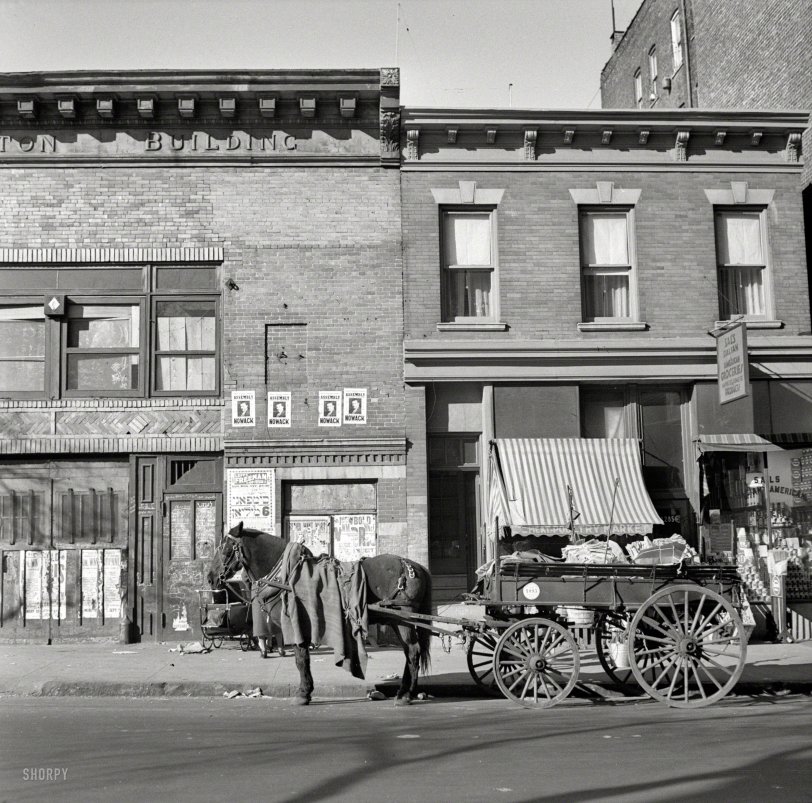


Framed or unframed, desk size to sofa size, printed by us in Arizona and Alabama since 2007. Explore now.
Shorpy is funded by you. Patreon contributors get an ad-free experience.
Learn more.

- I remember it well
- I can't prove it
- Complicated then, forgotten now
- Bryan-Stevenson
- Skinny is as skinny does
- How do you rest in peace
- Riding the footboards
- Alas, hidden from view
- Baldwin Diesels
- Exclusive pump
- Bananas, Oysters and Smokey Joe
- Details, Details
- What's that building to the left of the tower?
- Coal Barges
- Bromo-Seltzer
- Inner harbor
- The Basin
- What a headache!
- Giant stepladder?
- Yeah, it was cold
- Love those coats
- Link & Pin Days Remnant
- Baldwin 62303
- Baldwin VO-1000
- Cold
- No expense spared
- Tough Guys
- What's your hurry, where's your hat?
- Sheriff's Signature
- Relocated in the Eighties
Print Emporium
Sal's Italian Groceries: 1936

December 1936. "Scene from the Bronx tenement district from which many of the New Jersey homesteaders have come." Another example of the ostensibly onerous conditions from which the Resettlement Administration offered an escape. Medium-format nitrate negative by Arthur Rothstein. View full size.
War Delays the March of Progress
While many will see this horse and wagon as a fading relic of former times, if not an outright anachronism, World War II, with its rationing of fuel and tires, gave such conveyances a brief reprieve. I recall as a tot in Cleveland seeing milk delivered by horse and wagon (most of the dairies had but recently mechanized and the horses, who knew the routes better than the drivers, were still available). Likewise, various peddlars and, of course, the "junk man" still made their rounds in horse-drawn conveyances for a time even after the war. Incidently, a recent satori decoded for me my childhood memory of the junk man's cry: Piper-ex Juice!" was probably my misunderstanding of "Paper, Rags, Jute!"
Flame
Meaning of the word in Hebrew script printed in chalk to the left of the Freeman poster, with what looks like an exclamation point after it. (Hebrew and Yiddish read right to left.) What in the world is that chalked-upon door about?
Not just the northeast!
We had (and to a lesser extent still have) many of the same shops here in California. I remember exactly the same experiences you described, shopping at Traverso's and Arrigoni's - the smells, the label art, the sausages and hams hanging over the butcher counter, and always a "taste" of cheese and salami for the kids. Fresh ravioli, covered in flour in flat white boxes, packs of exotic looking pastas, sliced deli products in white butcher paper going home, and only around Christmas, those tiny boxes of nougat candy, with the intricate cameo portraits on the outside... Yeah, me, too! (Arrigoni's is still open, since 1937, but Traverso's is sadly gone from Santa Rosa.)
Leffs Freeman Poster
Is a Yiddish language advertisement for the 1932 film Symphony for 6 Million. In the 1930s and 40s the juxtaposition of a Italian Grocery and an advertisement in Yiddish would have been common in The Bronx. This was the area that my Grandparents escaped to when they were able to afford to leave the Lower East Side. The other destination of choice would have been East Harlem.
Onerous conditions?
I agree with your use of the term "ostensibly" when describing the living conditions. This is 1936 and these properties don't look that "onerous". As in other photos you've posted from this area and era, they don't look any worse than the area I lived my first five years in Chicago from 1950-1955. We weren't rich, but not poor either. My Dad was a school teacher.
Italian grocery stores
Having lived my first 22 years in the northeast, I used to love going into these stores. I can still smell the irresistible aroma of salami, aged cheeses, oregano and garlic, freshly baked breads and incredible delicacies. As a child who loved artwork, I would study all the beautiful labels and intricate signage on the illustrated metal gallon cans of olive oil, the Roma tomatoes with basil, the talented arrangements of multicolored pickled peppers in lavishly shaped jars, very detailed wine labels, the packaged sweets, etc. while my parents shopped. I still marvel at the artistic quality of those (suitable for framing) masterpieces used on their imported foods, all the colors and pastoral scenic depictions of Italy. Since I have not been in one for over fifty years, I have to wonder if their labeling and aromas are still so intriguing. Obviously the artisans who designed these labels took great care to make them fascinating and inviting. I want to go back there.

























On Shorpy:
Today’s Top 5